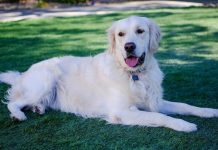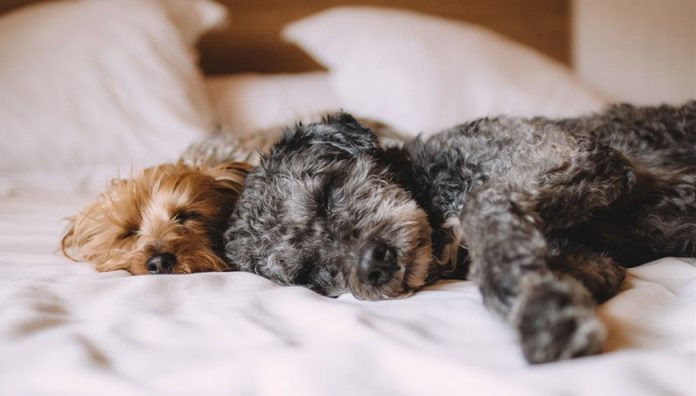Why do puppies breathe fast while sleeping? When it comes to human babies, the rapid breathing is due to the incapability of their lungs to hold a lot of oxygen. Is it the same reason for pups?
In this post, we’ll take a look at all the possible reasons for the sleeping behavior of puppies. We will help you determine if it’s normal or if it requires a trip to the vet.
Puppies and Their Sleeping Habits
Sleep is essential for the healthy growth of puppies. On average, young dogs spend 15-20 hours a day catching some Zs.
It’s normal for dogs to breathe heavily while they sleep. If your pup is twitching, kicking, and looking like he is chasing something, it’s probably because he is just dreaming.
Do canines dream? It’s difficult to say that puppies and adult dogs dream the same way as humans but scientists believe that they dream. During a Rapid Eye Movement (REM) sleep, dogs bark and even twitch their legs.
Canines have three sleep stages. Aside from the REM one, they also go through non-rapid eye movement and short-wave sleep (SWS). When your pup breathes heavily during slumber, he is in an SWS stage.
If your puppy growls, cries and looks troubled while sleeping, he might be having a bad dream. It’s possible for young dogs to have a bad dream especially if they are rescue dogs or have experienced anything traumatic.
When a puppy looks like he is having a nightmare, simply call his name and don’t attempt to touch him. This might surprise him and he might even bite you.
Puppies and senior dogs dream more than middle-aged dogs. They often start dreaming 10-20 minutes after falling asleep. There’s no reason to panic if you see him twitching while sleeping.
Sometimes, puppies pant heavily after playing outside. A puppy’s wake-time length ranges from 4-9 hours, depending on their age.
They usually use a lot of energy when they are awake. If they pant very fast while resting, it could be that they are just trying to catch their breath and that’s normal.
Other Possible Causes of Rapid Breathing In Puppies
In medical and veterinary terms, an increased respiratory rate is called tachypnea. According to the Animal Emergency Center, the normal respiratory rate for canines is 15-40 breaths per minute. This is the same rate for small toy breeds.
Normally, it’s the chest that should expand while your puppy is breathing. You’ll know something is wrong with your puppy if it’s the abdomen that’s expanding instead of his chest.
Measuring your puppy’s respiratory rate is the best way to figure out if his rapid breathing is something to be concerned about.
How to Measure a Puppy’s Breathing Rate
Checking your dog’s vital signs, including this respiratory rate can be easy with the right technique. Here are the ways to do it from home:
- Wait for your dog to sleep quietly. It’s best to do the evaluation while the dog is resting or when he is calm. A dog’s blood oxygen levels normally go up after a physical activity or when it is anxious or excited.
- Observe the chest by sitting close enough to see his sides. It’s not advisable to pet or touch the puppy because this may disturb him. Canines need a deep and uninterrupted sleep the way humans do.
- Get your dog’s minute rate by counting the number of times his chest goes up and down. You can do it using a stopwatch. You can also simply count his chest movements for 15 seconds and multiply it by four.
- Jot down the dog’s rate in a journal. You can use free smartphone apps for your convenience. Most of the apps nowadays allow users to track a dog’s respiratory rate, compare the results over time, and upload the information directly to their vet.
When to Seek A Vet’s Help
Contact your veterinarian if your pup’s breathing rate is more than 40 breaths per minute. If it is associated with other symptoms, it could be a respiratory problem.
It’s also possible that it’s a sign of a heart failure. A dog with 40-60 breaths per minute could be suffering from congestive heart failure.
Respiratory Disease in Young Dogs
There are six common canine respiratory infections: canine infectious tracheobronchitis, canine rhinovirus, tonsillitis, lung parasites, respiratory tract tumors, and pneumonia.
Canine infectious tracheobronchitisor a kennel cough is mostly detected among young dogs. They are prone to this kind of infection because of their underdeveloped immune systems.
A kennel cough is comparable to common colds in humans. Dogs get it from coming in contact with micro-organisms infected with the Bordetella bronchiseptica bacteria.
The signs of a respiratory problem in puppies are as follows:
- Dry “honking” cough
- Inactivity
- Fever
- Decreased appetite
- Regular and chronic coughing
Identifying kennel cough involves going through your pet’s medical history. Your vet will also have to check the pup’s urine and blood.
Puppies with kennel cough are usually prescribed an anti-inflammatory medication to lessen the pain associated with coughing. Most of the time, puppies heal by themselves. If it’s already severe, your vet will advise putting the puppy on antibiotics to ward off the infection.
Does your puppy need a kennel cough vaccination? No, especially if your pup is not at specific risk of having it or if his immune system is not compromised. The kennel cough vaccine is only strongly advised for canines boarding in a kennel facility.
The only vaccine required by law is the rabies vaccine and your puppy should get it starting with the 12th week of life. The kennel cough vaccine is a type of non-core vaccine, which means you can decide if you want to get this for your dog or not.
The efficacy of this vaccine is quite contentious. There are instances when dogs still easily catch kennel cough even after being vaccinated.
Avoid bringing your dog in a kennel facility until he is over a year old. Obviously, there’s a higher risk of acquiring the virus if there are a lot of canines in one room. When your pup is already older than one, his immune system has already matured.
Heart Failure in Puppies
In some cases, a puppy’s rapid breathing is because he is having trouble grasping air. The difficulty in breathing can be a sign of an underlying heart condition.
Heart failures can be inherited, congenital, or only developed later in life. A first warning sign that your puppy has a failing heart is if he quickly becomes exhausted from exercise.
Healthy puppies are often hyperactive and enjoy playtime. They use lots of energy while they are awake because they spend the majority of the day sleeping.
The symptoms of heart failure are the following:
- Constant panting
- Getting tired easily
- Swollen abdomen
- Having difficulty breathing
- Dry cough especially at night
It’s best to seek veterinary care if the above symptoms are present. Other signs to keep an eye on are loud gasping sounds and shallow breathing.
Things to Do To Calm Your Puppy before Sleeping
- Providea cool and stress-free sleeping area for your puppy. A dog’s breathing rate can go higher when he is hot. Newborn puppies can be kept in an environment with a temperature between 29.5-32°C. This should be decreased as they grow older. Once a puppy reached its fourth week, he can comfortably sleep in a room with a 22.2°C temperature.
- Play a relaxing music before putting the puppy in his crate. Several researches suggest that music is powerful enough in calming dogs. Yes, puppies enjoy lullabies and classical music too. A study by the University of Glasgow in partnership with the Scottish SPCA revealed that classical music decreases stress in canines.
- Keep your pet hydrated. Giving him some water can help his breathing return to normal. When your puppy is dehydrated, his gums and tongue will be sticky instead of wet. It will also show up in the skin. If you grasp it and it takes a while before it returns to normal it means the pet might be dehydrated. Puppies need to have 10-20 ounces of water for every 20 pounds of body weight.
- Make him comfortable. The rapid breathing can be due to stress. If the puppy just moved in with you, it’s normal for him to have troubles settling in. Most puppies are taken from their mothers as early as eight weeks. Allow the puppy to explore at his own pace and only have short teaching sessions during the day.
Conclusion
More often than not, a puppy’s fast breathing while sleeping is normal. This happens just because he is dreaming. There is no need to seek veterinary care unless the tachypnea is associated with other symptoms such as fever, lethargy, and inappetence.






















